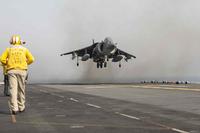Top U.S. Navy officials today made their case before the Senate Armed Services Committee today for buying both classes of Littoral Combat Ship as the deadline for Congress to grant the service permission to buy the ships fast approaches.
Navy Secretary Ray Mabus and Chief of Naval Operations Adm. Gary Roughead, repeatedly stressed that the dual by of 20 LCSs from both Lockheed Martin and Austal USA would save the service $2.9 billion over the next five years and allow the purchase of 10 ships from each class versus the 19 single class ships as previously planned.
The officials were speaking during a Dec. 14 hearing that was called by Sen. John McCain, R-Ariz., as the Senate this week considers an omnibus spending package that includes permission for the Navy to buy both classes of LCS.
That $2.9 billion could be redirected toward other shipbuilding programs while the Navy would get the "flexibility" of having two types of LCS with complementary skill sets, the service officials repeatedly said.
Navy acquisition chief Sean Stackley was also on hand for the effort, telling lawmakers that, based on Navy calculations that even account for production troubles, each ship would cost between $440 million to $480 million under the plan to buy both classes under a fixed price contract.
However, this deal will only be possible if the service is allowed to act before the end of the year due to cost increases associated with work stoppages at the LCS shipyards, Roughead told reporters after the hearing.
"What are the impacts of the work stoppage, what happens to the workforce?" said Roughead.
"In my case, as I look at the ships that are coming along, how long do I hold a crew in a training period," added the admiral. "If the ships are delayed I have to retrain them and they go to another ship or another station"
If the service isn't allowed to buy both ships this month, it will have to move ahead with plans to purchase one class of ship as originally planned, according to the CNO.
"That's the point that we find ourselves at right now," said Roughead.
Mabus echoed Roughead's comments when asked if the service would consider buying both classes of ships after the Dec. 30 deadline if the cost of buying both ships hikes.
"It's either we get the authority [to buy both] or we downselect" to one ship, said the secretary.
Still, McCain was not convinced that the program, which suffered numerous delays and cost hikes over the last decade, will live up to the sea service's fiscal projections. He urged lawmakers to continue studying the details of the Navy's dual buy well into the new year.
"I've never, in the 20-something years that I've been a member of this committee, approved a program where I don't know what the cost is," said McCain. He was referring to the fact that Navy officials cannot reveal the pricing information they received from both bidders due to contract regulations.
"I understand that the two very generous offers have now been extended to December 30 and I see no reason why those two very generous offers could not be extended to January or February or March so that this committee could at least address the concerns that the [Government Accountability Office, Congressional Budget Office] and the Congressional Research Service have raised." added the Senator.
He was referring to officials from the GAO, CBO and CRS, all of whom said they could not get a truly accurate read on the likely cost of the split buy without seeing the price of the bids. However, the chance of anyone outside of the Navy seeing that data is very unlikely, said Roughhead.
The officials from GAO, CBO and CRS also voiced concern over the prospect of increased costs from training crews, providing maintenance and upgrading two ship types.
While McCain remains unconvinced of the service's need to buy both class of LCS, committee chairman Carl Levin, D-Mich., backs the plan, saying he believes it will foster competition, keep costs down and help stabilize the shipbuilding industry throughout the 55-ship lifespan of the program.








